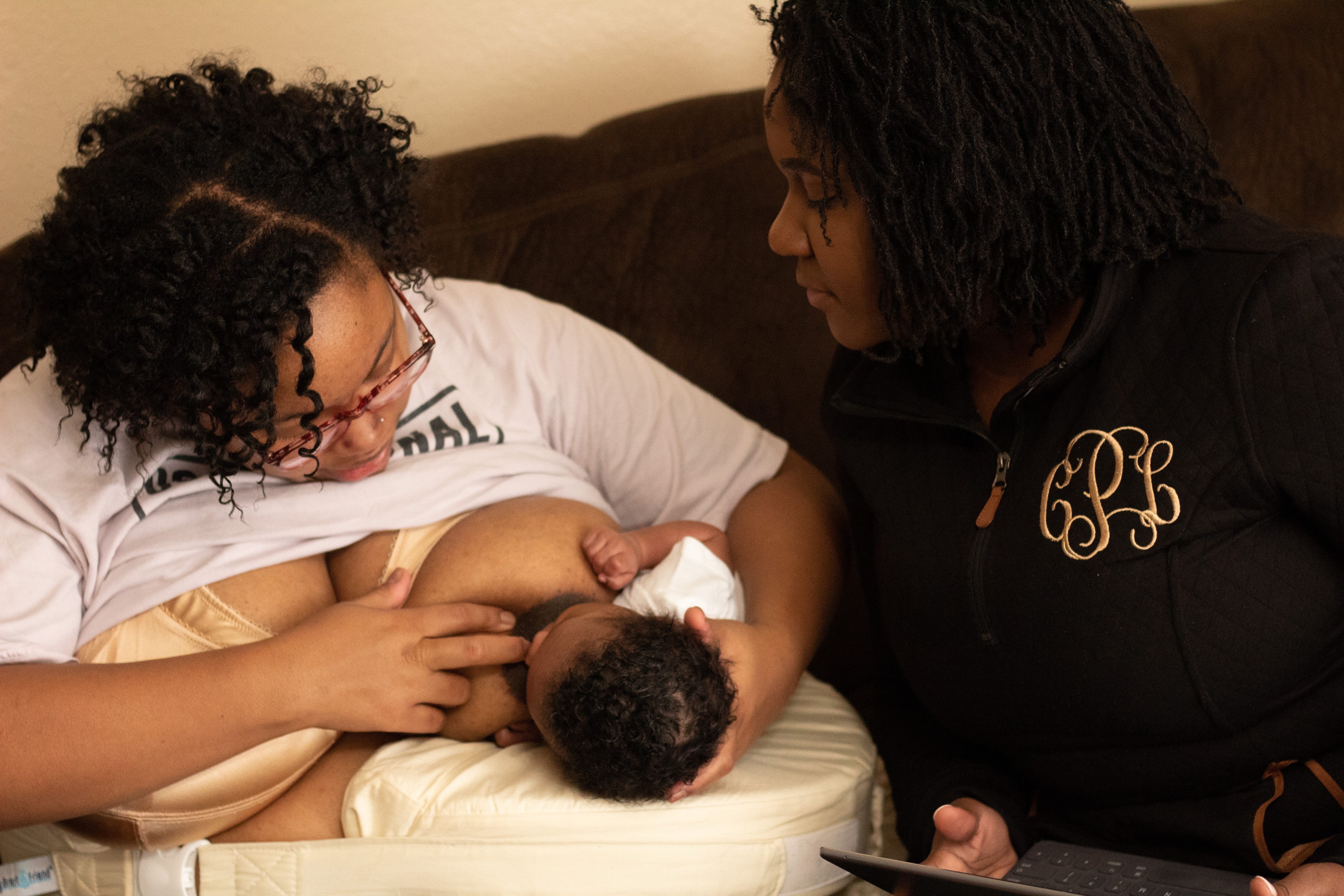On April 11-17, we celebrate Black Maternal Health Week (BMHW). According to the CDC, black women are currently three times more likely to die from pregnancy-related causes than white women. Continue reading to learn more about the current state of the U.S. maternal mortality rate, recommendations for pregnant families and healthcare providers, and how to be an advocate for maternal and reproductive health.
IN THIS ARTICLE:
What is Black Maternal Health Week?
What is the Current Maternal Mortality Status?
What is the Black Maternal Mortality Rate?
How Can We Help Reduce Black Maternal Mortality?
What Does Black Maternal Health Week Aim to Accomplish?
How Can Breastfeeding Success Impact Black Infant and Maternal Mortality?
What is Black Maternal Health Week?
Black Maternal Health Week (BMHW), is a movement that was created by the Black Mamas Matter Alliance (BMMA) “to build awareness, activism, and community-building to amplify the voices, perspectives and lived experiences of Black Mamas and birthing people” (BMHW, 2023).
Intentionally observed on April 11-17, during National Minority Health Month, it draws attention to our current maternal health crisis in the US, especially the racial disparity in reproductive and maternal health among black women. This year, the dialogue will be centered around the official theme, “Our Bodies Belong to Us: Restoring Black Autonomy and Joy” which focuses on the “values and traditions of the reproductive and birth justice movements” (BMMA, 2023). This theme is aimed at empowering black mothers to make well-informed, autonomous, birth and health decisions about their bodies to achieve holistic wellness.
As a postpartum RN, I have witnessed and advocated for women in countless “near misses” where early warning signs were ignored and decision making appeared to be clouded by unconscious bias. A common example was that black women weren’t “really” in a 10/10 pain because they appeared “too calm”- not considering this woman did not feel comfortable showing vulnerability to a provider that ignored her requests and did not seek to understand her as a person.
As a birth worker and birthing mom, I have also had the unfortunate experience of seeing black patients being treated differently and presented with less information to make a birth altering decision. There is a sense of powerlessness from women when they feel they can’t advocate for their birth experience without being labeled as “difficult.” There is also a sentiment of defeat after healthy moms are coerced to get non-emergent, un-medically necessary, inductions because labor is taking “too long.”
This theme of “Restoring Black Autonomy and Joy” is needed to help black women become more of a voice in their birth experience and more of an advocate and participant in their healthcare decisions.
What is the Current Maternal Mortality Status?
Currently, the US maternal mortality (death) rate has continued to worsen from 754 in 2019, 861 in 2020, to 1,205 in 2021 (CDC, 2023). In comparison with other high-income countries, the US maternal mortality rates are actually several times higher. Part of this can be contributed to the pandemic, however, 2 in 3 deaths are actually preventable (CDC, 2022a). Increased awareness and timely treatment of early warning signs can help to reduce the number of preventable deaths (CDC, 2022a).
What is the Black Maternal Mortality Rate?
According to the Centers for Disease Control and Prevention, “black women are 3 times more likely to die from pregnancy-related causes than white women” (CDC,2022a). In 2021, the national average of maternal mortality was 32.9 deaths per 100,00 births. However, the rate of deaths per live birth for non-Hispanic white women was under the average at 26.6 per 100,000 births. Whereas the rate of deaths per live birth for non-Hispanic Black women was more than 2 times the average at 69.9 deaths per 100,000 births. “Multiple factors contribute to these disparities, such as variation in quality healthcare, underlying chronic conditions, structural racism, and implicit bias” (CDC, 2022a).
How Can We Help Reduce Black Maternal Mortality?
For black women specifically, BMMA suggests implementing “culturally-congruent practices with a focus on Black Midwifery care and full-spectrum Black-led Doula care as sound, evidence-based solutions” (BMMA, 2023). Cultural congruence is when the provider and client understand each other and have a greater “fit”. As a provider, this includes being aware of their own values and morals while being culturally competent of the values, practices, beliefs, and whole life experiences of the black woman. This alignment with the provider can help to prevent unconscious bias in healthcare and improve the delivery of prenatal and postpartum care, including recognizing early warning signs and providing timely treatment (CDC, 2022a).
Among the organizations partnered with BMMA is the Commonsense Childbirth Institute, created by Jennie Joseph, to train and certify Midwives and Doulas for faster, on-the-ground, support. In addition to training culturally congruent providers, Jennie also created The National Perinatal Task Force (NPTF). The NPTF is a network of Perinatal Safe Spots with the goal of eliminating “racial and class disparities in birth outcomes, and to create equity and power in maternal child health care” (Joseph, 2022).
Current recommendations by the CDC to reduce black maternal mortality rates include a multi-level approach for families, healthcare providers, healthcare systems, states, and communities.
These recommendations include:
Pregnant people and their families can:
- Talk to a healthcare provider if anything doesn’t feel right or is concerning.
- Know and seek immediate care if experiencing any of the urgent maternal warning signs, including severe headache, extreme swelling of hands or face, trouble breathing, heavy vaginal bleeding or discharge, overwhelming tiredness, and more. These symptoms could indicate a potentially life-threatening complication.
- Document and share pregnancy history during each maternity care visit for up to one year after delivery.
- Maintain ongoing healthcare and social support systems before, during, and after pregnancy.
Healthcare providers can:
- Ask questions to better understand their patient and things that may be affecting their lives.
- Help patients, and those accompanying them, understand the urgent maternal warning signs and when to seek medical attention right away.
- Help patients manage chronic conditions or conditions that may arise during pregnancy like hypertension, diabetes, or depression.
- Recognize unconscious bias in themselves and in their office.
- Address any concerns patients may have.
- Provide all patients with respectful care.
Hospitals and healthcare systems can:
- Identify and address unconscious bias in healthcare.
- Standardize coordination of care and response to emergencies.
- Improve delivery of quality prenatal and postpartum care.
- Train non-obstetric care providers to ask about pregnancy history in the preceding year.
States and communities can:
- Assess and coordinate delivery hospitals for risk-appropriate care.
- Support the review of the causes behind every maternal death.
- Identify and address social factors influencing maternal health such as unstable housing, transportation access, food insecurity, substance use, violence, and racial and economic inequality. (CDC, 2022a)
What Does Black Maternal Health Week Aim to Accomplish?
As a result of this movement, the hope is to reduce black maternal morbidity and mortality rates through policy-driven solutions that can address systemic racism and/or implicit bias, increase research on root causes of racial disparities, and incite community involvement. For more information on how to become more involved with this campaign and see which activities are available in your state here.
How Can Breastfeeding Success Impact Black Infant and Maternal Mortality?
Immediately post-birth, care should include the entire mother-baby dyad. So, along with the goal of eliminating maternal mortality and morbidity risks, it is important to remember the other part of the dyad- the infant. The infant mortality rate for black infants is 2.3 times higher than their white counterparts (CDC, 2022b). Among the top 5 reasons include preterm/low birth weight, SIDS, and maternal pregnancy complications.
Breastfeeding has many benefits for babies including reduced risk of NEC (a disease that mainly affects preterm babies), reduced risk of SIDS, and immune factors that help improve health outcomes, especially for preterm babies (CDC, 2019). Breastfeeding is also protective to maternal health outcomes by decreasing the risk of high blood pressure, cancer, diabetes, and can help to prevent postpartum hemorrhaging (CDC, 2019)
Considering black women are at an increased risk for those protective factors, they have the lowest initiation rate of breastfeeding and the shortest duration because they are less likely to receive the support they need (CDC, 2019). Removing barriers such as systemic racism and unconscious bias can help increase the support and access to black moms. This increased focus and awareness on black maternal health can aid more at-risk infants to receive the optimal source of nutrition and protective factors for a healthier mom and baby!
References
2023 Black Maternal Health Week. Black Mamas Matter Alliance. (2023, March 30). Retrieved March 30, 2023, from https://blackmamasmatter.org/2023-black-maternal-health-week/
Advancing Black Maternal Health, Rights & Justice. Black Mamas Matter Alliance. (2023, February 9). Retrieved March 30, 2023, from https://blackmamasmatter.org/
Centers for Disease Control and Prevention. (2021, August 17). Racial and ethnic disparities in breastfeeding initiation ─ United States, 2019. Centers for Disease Control and Prevention. Retrieved March 30, 2023, from https://www.cdc.gov/mmwr/volumes/70/wr/mm7021a1.htm
Centers for Disease Control and Prevention. (2022, April 6). Working together to reduce Black Maternal Mortality. Centers for Disease Control and Prevention. Retrieved March 30, 2023, from https://www.cdc.gov/healthequity/features/maternal-mortality/index.html
Centers for Disease Control and Prevention. (2022, June 22). Infant mortality. Centers for Disease Control and Prevention. Retrieved March 30, 2023, from https://www.cdc.gov/reproductivehealth/maternalinfanthealth/infantmortality.htm
Centers for Disease Control and Prevention. (2023, March 16). Maternal mortality rates in the United States, 2021. Centers for Disease Control and Prevention. Retrieved March 30, 2023, from https://www.cdc.gov/nchs/data/hestat/maternal-mortality/2021/maternal-mortality-rates-2021.htm#:~:text=In%202021%2C%201%2C205%20women%20died,20.1%20in%202019%20(Table).
Joseph, J. (2022, November 2). About. National Perinatal Task Force. Retrieved March 28, 2023, from https://perinataltaskforce.com/about/
U.S. Department of Health and Human Services. (n.d.). Black maternal health week will be observed April 11–17. National Institutes of Health. Retrieved March 28, 2023, from https://orwh.od.nih.gov/in-the-spotlight/all-articles/black-maternal-health-week-will-be-observed-april-11-17










